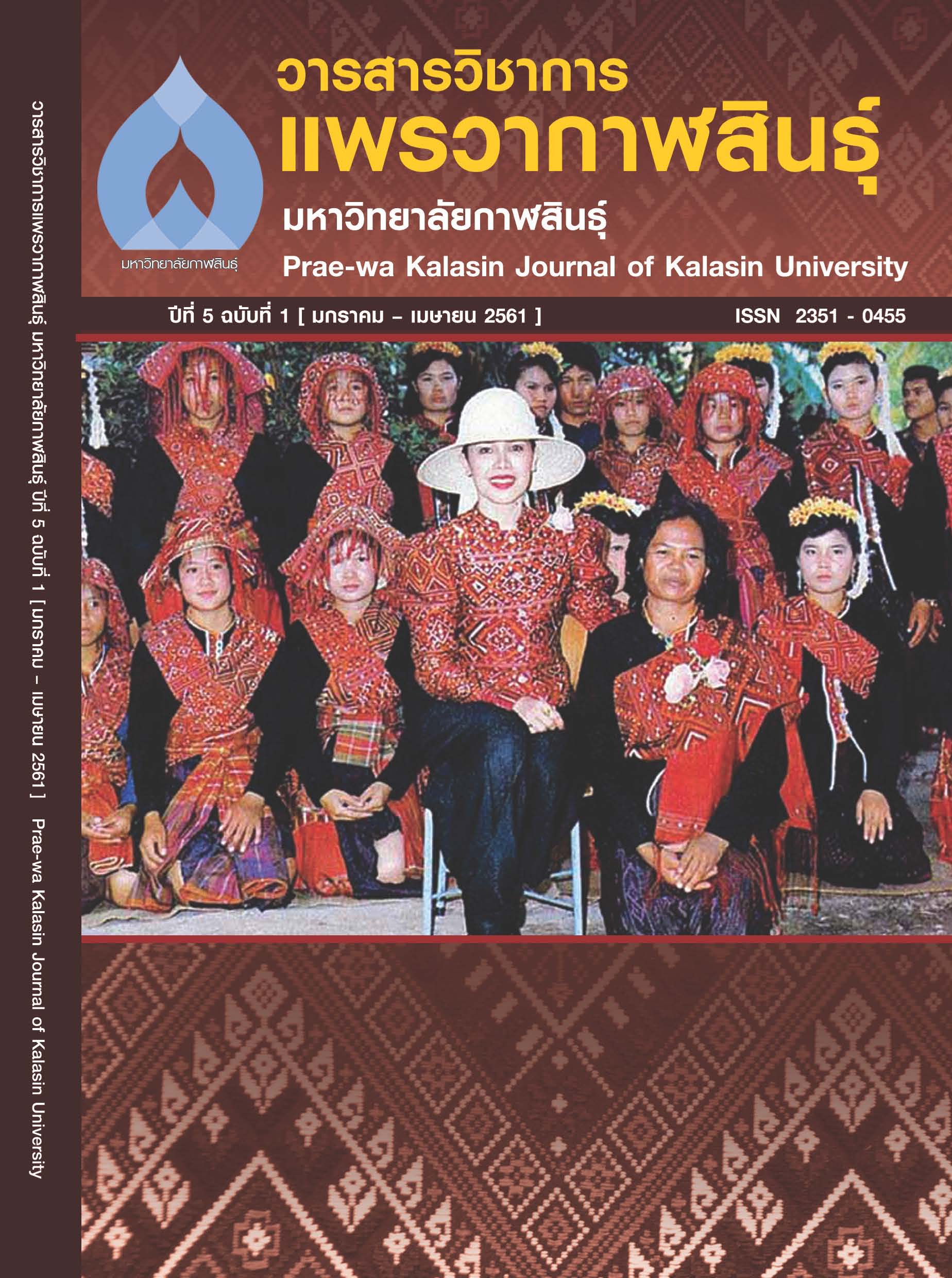The Development of Learning Activity Package in English Reading Comprehension Skills Based-on Brain Based Learning Approach for Mattayomsueksa 1 Students
Main Article Content
Abstract
The purposes of this research were: 1) to develop the learning activity package in English Reading Comprehension Skills based-on Brain Based Learning Approach for Mattayomsueksa 1 students with the efficiency value (E1/E2) of 75/75 2) to compare the students’ achievement after learning through the learning activity package with the criterion 80 % of full score 3) to compare the reading comprehension ability of the students between before and after using the learning activity package and 4) to study Mattayomsueksa 1 students’ satisfaction toward learning activity package in English reading comprehension skills based-on brain based learning approach. The sample consisted of 42 Mattayomsueksa ½ students by cluster sampling. The research instruments included the learning activity package, the lesson plans, test, the form of satisfaction evaluation. The statistics comprised percentage, mean, standard deviation, and t-test. The results of the research were as follows the learning activity package in English reading comprehension skills based-on brain based learning approach for Mattayomsueksa 1 students was 79.51/82.54. The students’ achievement after learning with the learning activity package was significantly higher than the criteria 80 percent at .05, and the posttest mean scores of English reading comprehension ability of the students were higher than those of pre-test at the .05 level of significance. The students’ satisfaction toward the learning activity package in English reading comprehension skills based-on brain based learning approach were at a high level of satisfaction.
Article Details
References
Ministry of Education. (2008). Core Curriculum for Basic Education Act 2551. Bangkok: Printing Agriculture Cooperatives of Thailand.
จันทิมา โพธิ์รัตน์. (2552). การพัฒนาทักษะการอ่านจับใจความภาษาอังกฤษของนักเรียนชั้นมัธยมศึกษาปีที่ 2 ด้วยการจัดกิจกรรมการเรียนรู้โดยใช้สมองเป็นฐาน. การศึกษาค้นคว้าอิสระ กศ.ม. มหาสารคาม: มหาวิทยาลัยมหาสารคาม.
Phorat, Jantima. (2009). The Develop English Comprehension Reading skill susing the brain as a base for Mattayomsueksa 2 Students. (Master’s Thesis). Mahasarakham University, Mahasarakham: Thailand.
ชุตินาฏ ชมศิลป์. (2552). การพัฒนาชุดกิจกรรมการอ่านภาษาอังกฤษเพื่อการสื่อสารโดยใช้รูปแบบการเรียนรู้แบบร่วมมือเรื่อง Thai Northern Food สำหรับนักเรียนชั้นมัธยมศึกษาปีที่ 1. (วิทยานิพนธ์ ค.ม. หลักสูตรและการสอน).
บัณฑิตวิทยาลัย, อุตรดิตถ์: มหาวิทยาลัยราชภัฏอุตรดิตถ์.
Chomsin, Chutinat. (2009). The Development Activities in English Reading Communications Using the form Collaborative Learning: Thai Northern Food for Mattayomsueksa 2 students. (Master’s Thesis). (Curriculum and Instruction). The College of Uttaradit Rajabhat University.
ดาราวรรณ แก้วศรีทอง. (2554). การพัฒนาแบบฝึกทักษะการอ่านจับใจความภาษาอังกฤษสำหรับนักเรียนชั้นมัธยมศึกษาปีที่ 1. (วิทยานิพนธ์ ค.ม.). อุบลราชธานี: มหาวิทยาลัยราชธานี.
Kaewsritong, Darawan. (2011). The Development of Reading Comprehension Skills in English for Mattayomsueksa 2 students. (Master’s Thesis). Ratchathani University, Ubon Ratchathani.
นิรมล ทิศอาจ. (2554). การพัฒนาชุดกิจกรรมภาษาอังกฤษ เรื่อง Environment สำหรับนักเรียนชั้นมัธยมศึกษาปีที่ 3 โดยใช้ทฤษฎีการสร้างความรู้ด้วยตนเอง. (วิทยานิพนธ์ ค.ม. หลักสูตรและการสอน). บัณฑิตวิทยาลัย, มหาวิทยาลัย
ราชภัฏอุตรดิตถ์.
Tis-art, Niramon. (2011). Development English Activities: Environment, the Theory of the Creation Of Self-knowledge for Mattayomsueksa 3 Students. (Master’s Thesis). The College of Uttaradit Rajabhat
University. Thailand.
บุญเกื้อ ควรหาเวช. (2542). นวัตกรรมทางการศึกษา (พิมพ์ครั้งที่ 4). กรุงเทพฯ: เอสอาพริ้นติ้ง.
Kuanhawech, Boonkue. (1999). Educational Innovation. (4th ed.). Bangkok: SR Printing.
พรพิไล เลิศวิชา และ อัครภูมิ จารุภาภร. (2550). สมองการเรียนรู้. กรุงเทพฯ: สถาบันส่งเสริมอัจฉริยภาพและนวัตกรรมการเรียนรู้.
Lertwicha, Pornpilai & Charupaporn, Akraphum. (2007). Brain Learning. Bangkok: Institute for Gifted and Innovative Learning.
ภัทรภร ชนะผล. (2556). การสร้างชุดกิจกรรมพัฒนาทักษะการอ่านเพื่อความเข้าใจเรื่องความเป็นเมืองแกลง สำหรับนักเรียนชั้นมัธยมศึกษาปีที่ 3. ระยอง: โรงเรียนมกุฎเมืองราชวิทยาลัย.
Chanaphon, Patraphorn. (2013). Creating a Series of Activities to Develop Reading Comprehension Skills: The city of Klang for Mattayomsueksa 3 Students. Rayong: Magudmueang Ratchawittayalai School.
โรงเรียนปทุมรัตต์พิทยาคม. (2559). รายงานผลการสอบคัดเลือกเข้าศึกษาต่อ ประจำปีการศึกษา 2559. ร้อยเอ็ด: โรงเรียนปทุมรัตต์พิทยาคม.
Pathumrat Pittayakom School. (2016). The report of the examination admission 2016 Academic Year. Phathumrat, Pittayakom Roi Et.
วิมลรัตน์ สุนทรโรจน์. (2554). นวัตกรรมเพื่อการเรียนรู้. มหาสารคาม: ภาควิชาหลักสูตรและการสอน คณะศึกษาศาสตร์ มหาวิทยาลัยมหาสารคาม.
Soontornroj, Wimonrat. (2011). Innovations for Learning. Department of Curriculum and Instruction Faculty of Education. Mahasarakham University.
วิโรจน์ ลักขณาอดิศร. (2550). การเรียนรู้โดยใช้สมองเป็นฐาน. กรุงเทพฯ: ซีเอ็ดยูเคชั่น.
Lakana-adisorn, Wiroj. (2007). Brain Based Learning. Bangkok: SE-ED.
_______. (2550). การเรียนรู้โดยใช้สมองเป็นฐานกับการสร้างเด็กเก่ง. กรุงเทพฯ: ซีเอ็ดยูเคชั่น.
_______. (2007). Learning by the Brain as a Base to Create Gifted Children. Bangkok: SE-ED.
สมยศ นาวีการ. (2544). การบริหารพัฒนาองค์กรและแรงจูงใจ. กรุงเทพฯ: บรรณากิจ.
Naveekan, Somyot. (2001). Management and Organizational Development Incentives. Bangkok: Bhannakij.
สำนักวิชาการและมาตรฐานการศึกษา. (2552). ตัวชี้วัดและสาระการเรียนรู้ ตามหลักสูตรแกนกลางการศึกษาขั้นพื้นฐาน พุทธศักราช 2551. กรุงเทพฯ: โรงพิมพ์ชุมนุมสหกรณ์การเกษตรแห่งประเทศไทย.
Bureau of Academic Affairs and Educational Standards. (2009). Indicators and learning as a core curriculum of Basic Education Act 2551. Bangkok: Printing Agriculture Cooperatives of Thailand.
สำลี รักสุทธี. (2553). คู่มือการจัดท�ำสื่อนวัตกรรมและแผนฯ ประกอบสื่อนวัตกรรม. กรุงเทพฯ: เพิ่มทรัพย์การพิมพ์.
Raksuthee, Somlee. (2010). Preparation of innovative media plan and accompanying media innovation. Permsap Printing.
สุคนธ์ สินธพานนท์. (2553). นวัตกรรมการเรียนการสอนเพื่อพัฒนาคุณภาพของเยาวชน. กรุงเทพฯ: อักษรเจริญทัศน์.
Sinthapanon, Sukon. (2010). Innovative Teaching and Learning to Improve the Quality of Youth. Bangkok: Aksorn CharoenTat.
สุนทร โคตรบรรเทา. (2548). หลักการเรียนรู้โดยเน้นสมองเป็นฐาน. กรุงเทพฯ: สถาบันพัฒนาผู้บริหารการศึกษา สำนักงานปลัดกระทรวง กระทรวงศึกษาธิการ.
Kotbantao, Soontorn. (2005). The Principles of Brain Base Learning. Bangkok: Institute of Management StudiesMinistry of Education.
Caine, G., & R. N., Caine. (1990). “Understanding a Brain-Based Approach to Learning and Teaching.” Educational Leadership, 48(2), 66-70.
Ozden, Muhammet & Gultekin, Mehmet. (2008). The Effects of Brain-Based Learning on Academic Achievement and Retention of Knowledge in Science Course.
T. Geisel. (1978). Theory of Roman scattering from relaxation processes in crystals. Proceedings of the 6th International Conference on Roman Spectroscopy, edited by E.D. Schmidt. Heyden and Son,
London. p. 214.

